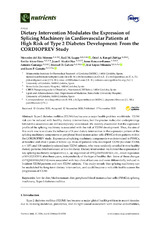Mostrar el registro sencillo del ítem
Dietary Intervention Modulates the Expression of Splicing Machinery in Cardiovascular Patients at High Risk of Type 2 Diabetes Development: From the CORDIOPREV Study
| dc.contributor.author | Río Moreno, Mercedes del | |
| dc.contributor.author | Luque, Raúl M. | |
| dc.contributor.author | Rangel Zúñiga, Oriol Alberto | |
| dc.contributor.author | Alors-Pérez, Emilia | |
| dc.contributor.author | Alcalá Díaz, Juan Francisco | |
| dc.contributor.author | Roncero-Ramos, Irene | |
| dc.contributor.author | Camargo García, A. | |
| dc.contributor.author | Gahete Ortiz, Manuel D. | |
| dc.contributor.author | López-Miranda, José | |
| dc.contributor.author | Castaño, Justo P. | |
| dc.date.accessioned | 2020-11-17T08:23:47Z | |
| dc.date.available | 2020-11-17T08:23:47Z | |
| dc.date.issued | 2020 | |
| dc.identifier.uri | http://hdl.handle.net/10396/20717 | |
| dc.description.abstract | Type-2 diabetes mellitus (T2DM) has become a major health problem worldwide. T2DM risk can be reduced with healthy dietary interventions, but the precise molecular underpinnings behind this association are still incompletely understood. We recently discovered that the expression profile of the splicing machinery is associated with the risk of T2DM development. Thus, the aim of this work was to evaluate the influence of 3-year dietary intervention in the expression pattern of the splicing machinery components in peripheral blood mononuclear cells (PBMCs) from patients within the CORDIOPREV study. Expression of splicing machinery components was determined in PBMCs, at baseline and after 3 years of follow-up, from all patients who developed T2DM (Incident-T2DM, n = 107) and 108 randomly selected non-T2DM subjects, who were randomly enrolled in two healthy dietary patterns (Mediterranean or low-fat diets). Dietary intervention modulated the expression of key splicing machinery components (i.e., up-regulation of SPFQ/RMB45/RNU6, etc., down-regulation of RNU2/SRSF6) after three years, independently of the type of healthy diet. Some of these changes (SPFQ/RMB45/SRSF6) were associated with key clinical features and were differentially induced in Incident-T2DM patients and non-T2DM subjects. This study reveals that splicing machinery can be modulated by long-term dietary intervention, and could become a valuable tool to screen the progression of T2DM. | es_ES |
| dc.format.mimetype | application/pdf | es_ES |
| dc.language.iso | eng | es_ES |
| dc.publisher | MDPI | es_ES |
| dc.rights | https://creativecommons.org/licenses/by/4.0/ | es_ES |
| dc.source | Nutrients 12(11), 3528 (2020) | es_ES |
| dc.subject | Low-Fat diet | es_ES |
| dc.subject | Mediterranean diet | es_ES |
| dc.subject | Peripheral blood mononuclear cells (PBMCs) | es_ES |
| dc.subject | Splicing machinery | es_ES |
| dc.subject | Type-2 diabetes mellitus | es_ES |
| dc.title | Dietary Intervention Modulates the Expression of Splicing Machinery in Cardiovascular Patients at High Risk of Type 2 Diabetes Development: From the CORDIOPREV Study | es_ES |
| dc.type | info:eu-repo/semantics/article | es_ES |
| dc.relation.publisherversion | http://dx.doi.org/10.3390/nu12113528 | es_ES |
| dc.relation.projectID | Instituto de Salud Carlos III. PIE14/00005 | es_ES |
| dc.relation.projectID | Instituto de Salud Carlos III. PIE14/00031 | es_ES |
| dc.relation.projectID | Instituto de Salud Carlos III. PI16/00264 | es_ES |
| dc.relation.projectID | Instituto de Salud Carlos III. CP15/00156 | es_ES |
| dc.relation.projectID | Instituto de Salud Carlos III. PI17/002287 | es_ES |
| dc.relation.projectID | Gobierno de España. BFU2016-80360-R | es_ES |
| dc.relation.projectID | Gobierno de España. TIN2017-83445-P | es_ES |
| dc.relation.projectID | Gobierno de España. PI13/00023 | es_ES |
| dc.relation.projectID | Gobierno de España. AGL2012/39615 | es_ES |
| dc.relation.projectID | Gobierno de España. AGL2015-67896-P | es_ES |
| dc.relation.projectID | Junta de Andalucía. BIO-0139 | es_ES |
| dc.relation.projectID | Junta de Andalucía. CTS-1406 | es_ES |
| dc.relation.projectID | Junta de Andalucía. CTS-525 | es_ES |
| dc.relation.projectID | Junta de Andalucía. PI-0541-2013 | es_ES |
| dc.relation.projectID | Junta de Andalucía. CVI-7450 | es_ES |
| dc.rights.accessRights | info:eu-repo/semantics/openAccess | es_ES |

